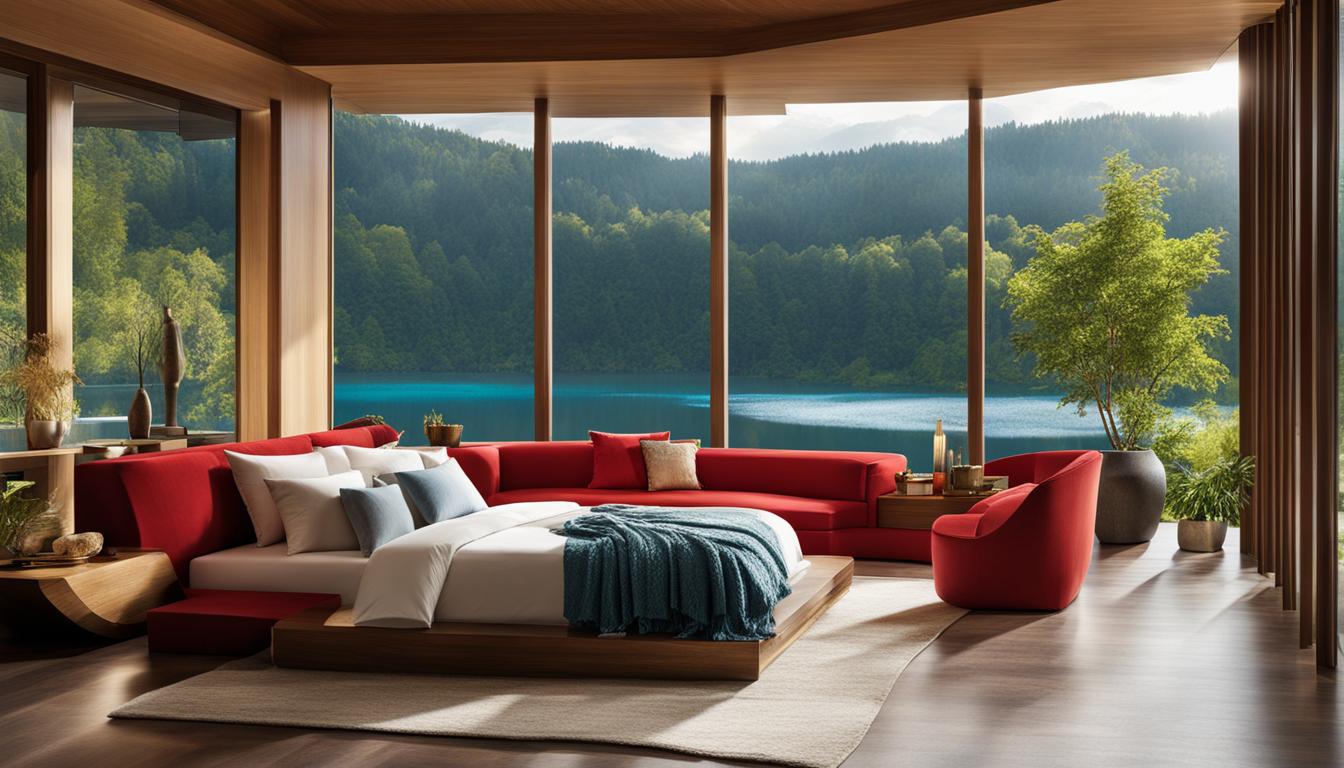Originally posted on October 28, 2023 @ 11:19 pm
Are you looking to create a harmonious living space that promotes good energy flow and overall well-being? Drawing a feng shui floor plan for your home may be just what you need. By incorporating feng shui principles into your design, you can optimize the energy flow and create a space that promotes balance and harmony.
In this section, we will guide you through the process of creating a feng shui floor plan for your home. We’ll cover everything from understanding feng shui principles to mapping out the bagua grid and optimizing the energy flow in your space.
Key Takeaways:
- Creating a feng shui floor plan can enhance the energy flow and harmony in your home.
- Understanding feng shui principles is essential before drawing your floor plan.
- Gathering information and measurements of your home is the first step in creating a feng shui floor plan.
- The bagua map is a vital tool in feng shui and can be used to optimize the energy flow in your space.
- Incorporating feng shui elements into your design can help create a visually appealing and energetically balanced space.
Understanding Feng Shui Principles
If you want to create a harmonious space with good energy flow, it’s important to understand the principles of feng shui. At its core, feng shui is the practice of arranging your environment to enhance the quality of your life. It involves creating balance and harmony within your space by optimizing the flow of energy, known as chi.
The Five Elements
One of the key concepts in feng shui is the use of the five elements: wood, fire, earth, metal, and water. Each element has its own characteristics and associations, such as the color, shape, and materials. By understanding the properties of these elements, you can incorporate them into your space to create a balanced environment.
The Bagua Map
Another important principle in feng shui is the use of the bagua map. This is a tool that divides your living space into nine areas of life, such as wealth, health, and relationships. By mapping out the bagua on your floor plan, you can identify which areas of your home correspond to each aspect of your life. This allows you to focus on enhancing specific areas to promote a well-rounded and fulfilling life.
The Yin and Yang Principle
Balance is critical in feng shui, and the yin and yang principle is central to achieving it. In feng shui, yin and yang energies represent the feminine and masculine aspects of your environment, respectively. By incorporating both into your space, you can create a harmonious and balanced living environment.
By understanding these principles, you can create a space that promotes positivity, balance, and overall well-being. Keep them in mind as you create your feng shui floor plan.

Gathering Information and Measurements
Before you start drawing your feng shui floor plan, it’s crucial to have accurate information and measurements of your home. Here are some floor plan tips to help you gather the necessary information:
- Measure the dimensions of each room, including the height, width, and length.
- Identify the location of doors, windows, and any built-in features such as fireplaces or cabinets.
- Take note of any natural elements that may impact the energy flow in your space, such as nearby water sources or landscaping.
- Consider the direction your home faces, as this can influence the amount of natural light and the flow of energy.
By taking the time to gather this information, you will be better equipped to create a feng shui floor plan that maximizes the positive energy in your home.

Mapping Out the Bagua Map
Mapping out the bagua map is a crucial step in creating a feng shui floor plan. The bagua map is an octagonal grid that represents the different areas of your home and how they correspond to different aspects of your life. By mapping out the bagua, you can identify areas in your home that require special attention and optimize the energy flow in your floor plan.
To get started, you’ll need to draw your floor plan and identify the main entrance. The main entrance is where energy enters your home, so it’s crucial to start here when mapping out the bagua.
Next, you’ll need to superimpose the bagua map over your floor plan. The bagua map has nine areas, each with a different significance:
| Bagua Area | Significance |
|---|---|
| Wealth | Abundance and prosperity |
| Fame and Reputation | Recognition and reputation |
| Love and Marriage | Relationships and partnerships |
| Family and Community | Health, family, and community |
| Skills and Knowledge | Self-cultivation and personal growth |
| Career | Life path and purpose |
| Helpful People and Travel | Connections and support |
| Children and Creativity | Future and creativity |
| Center | Health and balance |

Once you have the bagua map superimposed over your floor plan, you can assess the energy flow in each area. Is there clutter or obstacles blocking the flow of energy? Are there areas that are dimly lit or unused?
By answering these questions, you can identify areas that require attention and optimize the energy flow in your floor plan. In the next section, we’ll dive deeper into each area of the bagua and how you can enhance it to create a harmonious living environment.
Assessing Each Area of the Bagua
Once you have successfully mapped out the bagua grid on your floor plan, it’s time to assess each area and understand its significance.
The bagua map comprises eight areas that correspond to different aspects of your life. Each area is associated with a specific color, element, and shape that represent the energy or chi. Properly assessing each area of the bagua can help you understand where there may be blockages, clutter, or imbalances in your space.
Below is a table that outlines each area and its corresponding significance:
| Bagua Area | Color | Element | Shape | Significance |
|---|---|---|---|---|
| Wealth and Abundance | Purple | Wood | Rectangle | Represents financial abundance, prosperity, and good fortune |
| Fame and Reputation | Red | Fire | Triangle | Represents reputation, recognition, and fame |
| Love and Relationships | Pink | Earth | Heart | Represents love, relationships, and intimacy |
| Family and Health | Green | Wood | Rectangle | Represents physical health, family, and community |
| Center | Yellow | Earth | Square | Represents balance and harmony |
| Children and Creativity | White | Metal | Circle | Represents children, creativity, and free-spiritedness |
| Skills and Knowledge | Blue | Water | Wavy | Represents skills, knowledge, and higher learning |
| Career and Life Path | Black | Water | Wavy | Represents career, life path, and purpose |
Assessing each bagua area can help identify any areas of your life that may need improvement or attention. For example, if your love and relationships area is cluttered or missing, it may indicate a need to focus on those aspects of your life. Similarly, if your wealth and abundance area is blocked or cluttered, it could indicate a need to focus on your financial well-being.
Understanding the significance of each bagua area can help you optimize the energy flow in your floor plan and create a harmonious living environment.

Determining the Optimal Layout
After mapping out the bagua and assessing each area, it’s time to determine the optimal layout for your feng shui floor plan. Consider the size and shape of each room, as well as the function and energy of each area.
Here are some key principles to keep in mind when creating a layout for good energy:
- Ensure an open flow of energy throughout the space by avoiding clutter and keeping pathways clear.
- Place furniture in a way that promotes conversation and connection.
- Avoid placing furniture with sharp edges or angles, as they can create negative energy.
- Use feng shui principles of color and material to enhance the energy of each room.
When designing the layout, it’s important to keep in mind the function of each area. For example, the living room is a social space, so it should have an open and inviting layout for good energy flow and conversation. The bedroom, on the other hand, is a private and restful space, so it should have a peaceful and calming layout.
Take a look at the sample feng shui floor plan below for inspiration.
| Area | Color | Material | Furniture Placement |
|---|---|---|---|
| Living Room | Green | Wood | Sofa facing the entrance, chairs in a circular arrangement |
| Kitchen | Red | Fire | Stove and oven away from the sink, ample counter space |
| Dining Room | Yellow | Earth | Table centered in the room with chairs arranged in an oval or circular shape |
| Bedroom | Pale Blue | Water | Beds should be placed with the head against a solid wall, with a bedside table on each side |
| Bathroom | White | Metal | Keep the toilet seat down and the bathroom door closed at all times |
By following these principles and designing a layout that promotes good energy flow, you can create a harmonious and balanced feng shui floor plan for your home.

Designing with Feng Shui Elements
When it comes to designing a feng shui floor plan, incorporating feng shui elements can play a significant role in enhancing the energy flow and creating a visually appealing space. Feng shui elements include fire, earth, metal, water, and wood, each representing different aspects of nature.
Here’s how you can incorporate feng shui elements into your floor plan design:
| Element | Colors | Materials | Shapes |
|---|---|---|---|
| Fire | Red, orange, purple, pink | Candles, lights, electronics | Triangular, cone-shaped |
| Earth | Yellow, brown, beige | Bricks, tiles, pottery | Square, rectangular |
| Metal | White, gray, silver, gold | Metal objects, coins | Circular, round |
| Water | Blue, black | Water features, mirrors | Wavy, asymmetrical |
| Wood | Green, brown | Plants, wooden objects | Rectangular, column-shaped |
Keep in mind that each element represents a specific aspect of nature and should be used in balance. For example, too much fire element can cause aggression, while too much water element can lead to depression.
You can also use feng shui elements to balance specific areas of the bagua map. For instance, if the wealth area of your floor plan is lacking the earth element, you can add a potted plant or a brown rug to enhance stability and financial prosperity.
By designing with feng shui elements, you can create a space that not only looks beautiful but also promotes positive energy flow.

Enhancing the Flow of Energy
Creating a harmonious feng shui floor plan requires optimizing the energy flow throughout your space. Here are some practical tips and techniques for enhancing the flow of energy:
Eliminate Clutter
Clutter disrupts the natural flow of energy in your home. Make sure to declutter regularly and keep your space organized.
Arrange Furniture Thoughtfully
The way you arrange furniture can greatly impact the energy flow in your home. Make sure your furniture is not blocking any pathways and that your seating areas promote conversation and connection.
Lighting is Key
Effective lighting can create a warm and welcoming atmosphere while also promoting good energy flow. Natural light is ideal, but if that’s not an option, make sure to incorporate adequate lighting in your space.
Create Clear Pathways
Pathways should be free of obstacles and allow energy to circulate freely throughout your space. Consider using mirrors to reflect light and create the illusion of more space while also enhancing the flow of energy.

Choose Appropriate Colors
The colors you use in your space can impact the energy flow. Each color is associated with different feng shui elements and can influence different aspects of your life. Make sure to choose colors that align with your intentions for each area of your home.
Use Plants to Purify the Air
Plants not only add a natural element to your space but also help purify the air and promote good energy flow. Consider incorporating plants that are known for their air-purifying properties, such as snake plants or peace lilies.
By following these tips and incorporating feng shui principles, you can optimize the energy flow in your feng shui floor plan and create a harmonious living environment.
Balancing Yin and Yang Energies
In feng shui, achieving balance between yin and yang energies is crucial to create a harmonious living space. Yin represents feminine energy, while yang represents masculine energy. The goal is to create a balance between the two energies to promote a sense of equilibrium and overall well-being.
One way to balance yin and yang energies in your feng shui floor plan is to incorporate both masculine and feminine elements throughout your space. For example, you can introduce more yang energy in your living room by using bright colors, bold patterns, and angular shapes. On the other hand, you can create a softer, more yin energy in your bedroom by using soothing colors, soft textures, and rounded shapes.
Additionally, you can balance yin and yang energies by paying attention to the placement of furniture and objects in your space. For instance, placing a large, heavy object on one side of the room can create a sense of imbalance and excess yang energy. You can counteract this by placing a lighter, softer object on the opposite side of the room to create a sense of harmony.
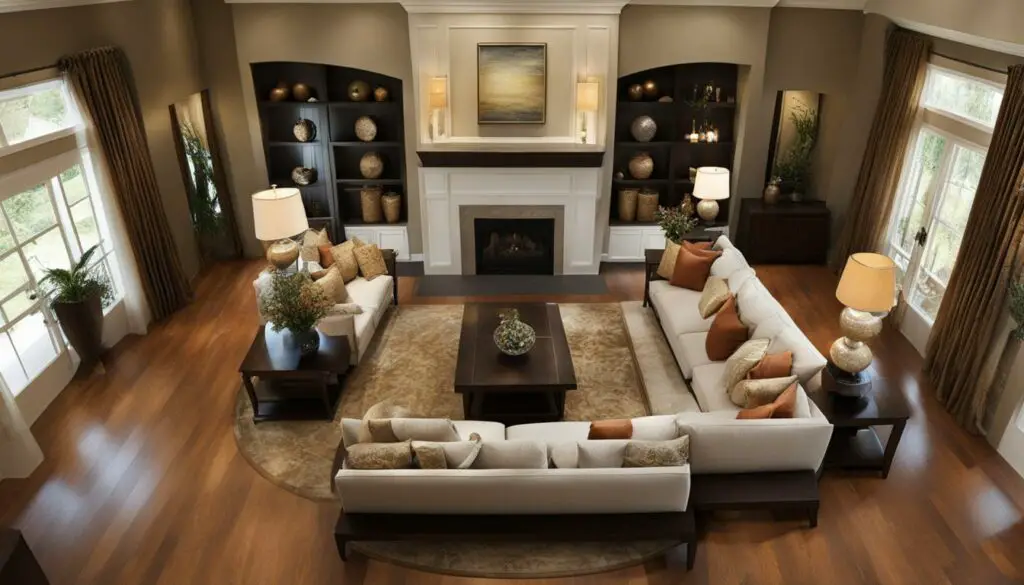
By incorporating both yin and yang energies in your feng shui floor plan, you can create a space that promotes balance and harmony, leading to a happier, healthier home.
Optimizing Bedroom Layouts
When it comes to feng shui floor plan design, optimizing your bedroom layout is crucial. Your bedroom is where you spend a significant amount of time resting and rejuvenating, so it’s essential to ensure that the energy flow in this space is positive and conducive to restful sleep.
One of the first things to consider when optimizing your bedroom layout is the placement of your bed. Ideally, your bed should be placed in the “command position” of the room, which is diagonally across from the door. This placement allows you to see the entrance to the room while you’re lying in bed, giving you a sense of security and control.
You should also avoid placing your bed under a window or directly facing a door. Both of these placements can disrupt the flow of energy in your bedroom and make it difficult to relax and sleep peacefully. If you can’t avoid these placements, consider using a solid headboard and curtains to block the flow of energy.
|
Do |
Don’t |
|---|---|
|
|
In addition to bed placement, it’s important to choose supportive and comfortable bedding and a mattress that provides the right amount of support for your body. When it comes to color, choose soothing and calming colors like blues, greens, and neutral tones. Avoid using bright or stimulating colors in your bedroom decor, as they can disrupt the flow of energy and make it difficult to fall asleep.
You may also want to consider incorporating feng shui elements like plants, crystals, or artwork into your bedroom decor. These items can promote relaxation and positive energy flow in your space.
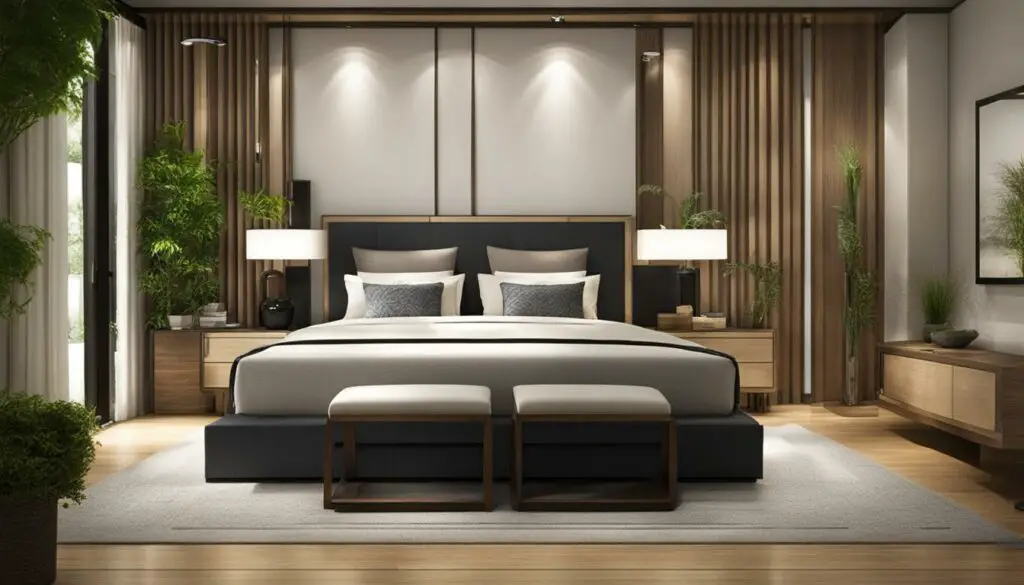
By optimizing your bedroom layout in accordance with feng shui principles, you can create a relaxing and rejuvenating space that promotes restful sleep and positive energy flow.
Maximizing the Energy of Living Spaces
Living spaces are the heart of any home, and optimizing their energy flow is crucial in creating a harmonious environment. There are several feng shui principles you can follow to ensure your living spaces promote good energy and balance.
Arranging Furniture
When arranging furniture in your living spaces, consider the flow of energy and how it can circulate freely. Avoid placing furniture in awkward positions or blocking pathways, as this can impede the flow of energy. Instead, arrange furniture in a way that promotes conversation and socializing while allowing energy to move around the space.
You can also use feng shui to select furniture pieces that align with your design goals. Choose shapes and materials that balance the elements of wood, fire, earth, metal, and water to create a visually appealing and energetically balanced space.
Effective Lighting
Lighting is another critical aspect of feng shui in living spaces. Use natural lighting when possible, but also incorporate artificial lighting that offers a comfortable, warm glow. Avoid harsh or overly bright lighting that can create an uncomfortable environment.
You can also use lighting to highlight certain areas of the living space. For example, use a floor lamp to illuminate a reading corner or a pendant light to draw attention to a piece of artwork.
Creating a Welcoming Atmosphere
Finally, consider the overall atmosphere you want to create within your living spaces. Use feng shui principles to select colors, materials, and decor that promote balance and harmony.
For example, use soft, warm colors like beige, peach, or light blue to promote relaxation and tranquility. You can incorporate natural materials like wood or stone to add an earthy element to the space.
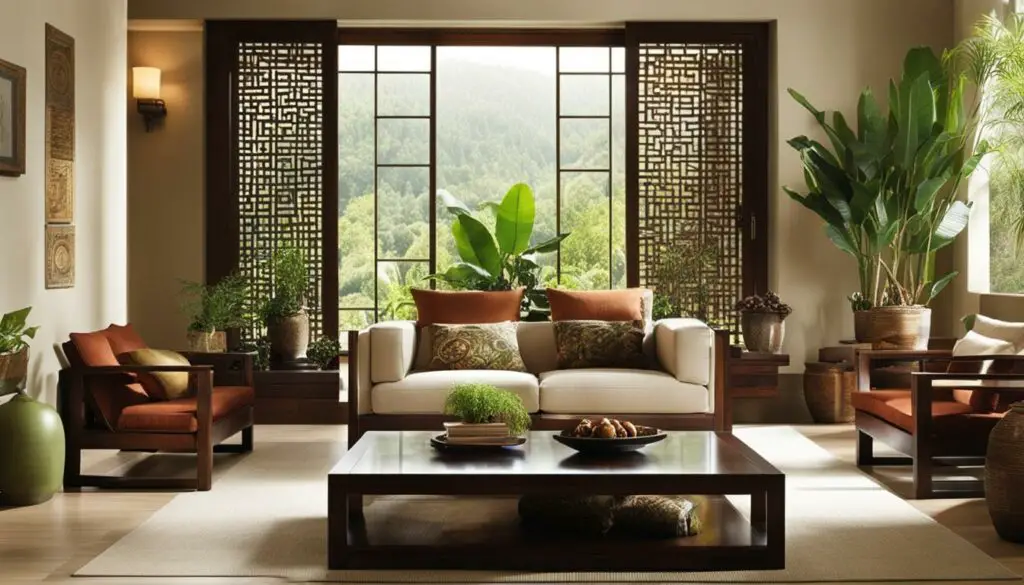
| Do: | Don’t: |
|---|---|
| Arrange furniture in a way that promotes socializing and conversation. | Block pathways with furniture, impeding energy flow. |
| Use natural and artificial lighting to create a warm, comfortable atmosphere. | Use harsh or overly bright lighting that can create an uncomfortable space. |
| Choose colors, materials, and decor that promote balance and harmony. | Use clashing color schemes or materials that create an unbalanced look. |
By following these feng shui principles, you can effectively maximize the energy flow and create a welcoming atmosphere in your living spaces.
Incorporating Feng Shui in Home Office Design
Many of us spend a significant portion of our day working from home. Therefore, it’s essential to create a home office space that promotes productivity, creativity, and positivity. By incorporating feng shui principles in your home office design, you can create a space that feels inviting and functional.
Firstly, consider the placement of your desk. Your desk should be placed in a position that allows you to see the door but not directly in line with it. This placement helps you feel secure and in control while also preventing distractions.
The color scheme is also important in a home office. Depending on the nature of your work, you may want to choose colors that promote focus, creativity, or tranquility. For example, blues and greens are calming and promote concentration, while yellow is associated with creativity and optimism. However, if your work requires a lot of time in front of the computer, it’s best to avoid bright colors as they can strain your eyes.
Another key factor in feng shui home office design is lighting. Ensure that your office is well-lit with natural and artificial light. Position your desk to take advantage of natural light, but also consider a good desk lamp to prevent eye strain and headaches. You may also want to consider incorporating candles or a Himalayan salt lamp for added ambiance and relaxation.
Plants can also be a great addition to your home office space. Not only do they help purify the air, but they are also known to reduce stress and increase focus. Consider placing a small plant on your desk or a larger plant in a nearby corner of the room.
Conclusion
Creating a home office that aligns with feng shui principles is a simple way to improve your overall well-being and productivity. By carefully considering the placement of furniture, color schemes, lighting, and incorporating natural elements, you can create a space that nourishes your mind, body, and soul.
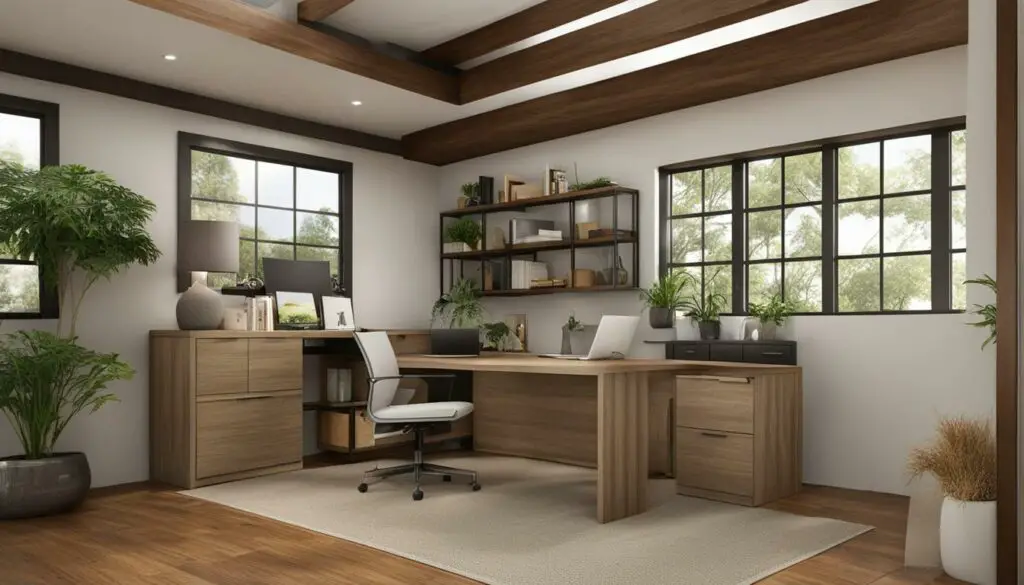
Creating a Harmonious Outdoor Space
When designing a feng shui floor plan, it’s essential to consider your outdoor space as well. Your outdoor environment can have a significant impact on the energy flow and overall harmony of your home. By creating a harmonious outdoor space, you can enhance your connection with nature and create a peaceful oasis for relaxation and rejuvenation.
Connecting with Nature
One of the primary goals of feng shui is to create a harmonious relationship between people and their environment. Your outdoor space provides an opportunity to connect with nature, which can have a positive impact on your well-being. Incorporating natural elements such as plants, water features, and rocks can help create a calming and peaceful atmosphere.
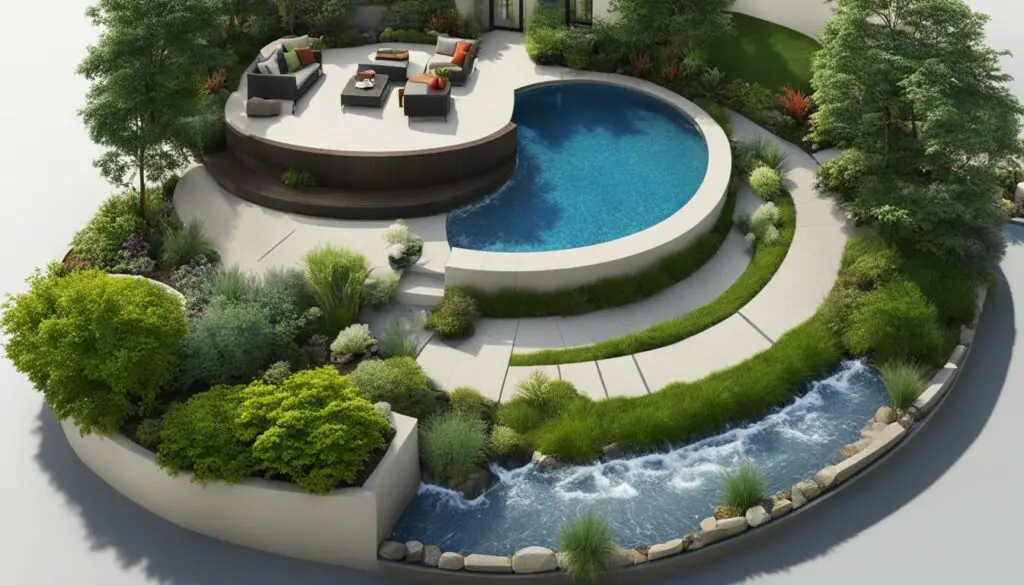
Considering the Bagua
When designing your outdoor space, it’s also important to consider the bagua map. Mapping out the bagua grid on your outdoor area can help you identify specific areas that correspond to different aspects of your life. For example, the front of your home corresponds to career and life path, while the back of your home corresponds to relationships and love. By optimizing each area of the bagua, you can create a well-balanced and harmonious outdoor environment.
| Bagua Area | Elements to Incorporate |
|---|---|
| Wealth and prosperity | Water features, wind chimes, vibrant flowers |
| Love and relationships | Plants, seating areas, romantic lighting |
| Fame and reputation | Outdoor art, bright colors, well-maintained landscaping |
| Family and community | Outdoor dining areas, comfortable seating, communal spaces |
| Health and well-being | Plants that promote health, exercise equipment, meditation areas |
| Children and creativity | Play areas, art installations, colorful décor |
| Knowledge and self-cultivation | Meditation gardens, quiet spaces, reflective areas |
| Career and life path | Well-maintained entrance, clear pathways, lighting |
Removing Clutter
Just like the inside of your home, the outdoor space should be free of clutter to maintain good energy flow. Remove any unnecessary items or objects that do not serve a purpose. Ensure that all pathways and entrances are clear of debris and well-maintained.
Optimizing Seating Areas
Seating areas in your outdoor space provide an opportunity to relax and enjoy the surroundings. It’s essential to optimize these areas by incorporating feng shui principles. For example, ensure that seating areas are positioned to take in the best views and aligned with the bagua map. Use comfortable and inviting seating and incorporate lighting to create a warm and inviting atmosphere.
Conclusion
Designing a harmonious outdoor space is just as important as creating a feng shui floor plan for the inside of your home. By incorporating natural elements, optimizing seating areas, and considering the bagua map, you can create a peaceful and rejuvenating environment that promotes balance and harmony.
Conclusion
Congratulations on completing the step-by-step guide to drawing a feng shui floor plan for your home. By incorporating feng shui principles into your space, you can create a more harmonious and balanced environment that promotes overall well-being.
Incorporating feng shui principles into your floor plan design does not have to be complicated. By understanding the underlying principles of feng shui and mapping out the bagua grid on your floor plan, you can identify specific areas in your home that correspond to different aspects of your life and optimize the energy flow in your space.
Start Small
If you are new to feng shui, start by incorporating small changes into your space, such as decluttering or adding plants. As you become more comfortable with the principles, you can gradually make more significant changes to your floor plan design to create a more harmonious and balanced environment.
Remember the Basics
Remember that creating a feng shui floor plan is about finding balance and harmony in your space. As you incorporate feng shui principles into your floor plan design, keep in mind the basics of good design, such as functionality, comfort, and aesthetics.
With a little patience and creativity, you can create a feng shui floor plan that promotes peace, balance, and overall well-being in your home. Start your journey to a harmonious home today!
FAQ
How can drawing a feng shui floor plan enhance the energy flow in my space?
Drawing a feng shui floor plan helps you create a well-designed layout that promotes balanced and harmonious energy flow in your home. By incorporating feng shui principles, you can optimize the flow of energy and create a space that supports overall well-being.
What are the underlying principles of feng shui?
The underlying principles of feng shui include balance, harmony, and the flow of energy. By understanding these principles, you can create a space that promotes positive energy and supports a harmonious living environment.
What information and measurements do I need to gather for my feng shui floor plan?
To get started, you’ll need to gather information and measurements about your home. This includes the size of each room, the location of doors and windows, and any architectural features that may impact the energy flow in your space.
What is the bagua map and how do I map it out on my floor plan?
The bagua map is a tool used in feng shui to identify different areas of your home that correspond to different aspects of your life. To map it out on your floor plan, you’ll overlay the bagua grid onto your floor plan and align it with the main entrance of your home.
What do I need to assess in each area of the bagua?
In each area of the bagua, you’ll need to assess the corresponding aspect of your life. For example, the wealth area relates to abundance and prosperity, while the love area pertains to relationships. By assessing each area, you can identify areas for improvement and enhancement.
How can I determine the optimal layout for my floor plan?
To determine the optimal layout for your floor plan, you’ll need to consider the principles of feng shui, such as the flow of energy and the placement of furniture. By following these principles, you can create a layout that promotes good energy flow and supports a harmonious living environment.
How can I incorporate feng shui elements into my floor plan design?
You can incorporate feng shui elements into your floor plan design by using colors, materials, and shapes that align with the principles of feng shui. For example, incorporating natural elements like plants or using calming colors can create a visually appealing and energetically balanced space.
What are some practical tips for enhancing the flow of energy in my floor plan?
Some practical tips for enhancing the flow of energy in your floor plan include decluttering your space, creating clear pathways, and organizing your furniture in a way that allows energy to circulate freely. By removing obstacles and creating a clear flow, you can optimize the energy in your space.
How can I achieve a balance between yin and yang energies in my floor plan?
Achieving a balance between yin and yang energies involves incorporating both masculine (yang) and feminine (yin) elements in your floor plan design. This can be done through the use of colors, patterns, and textures that represent both yin and yang qualities.
How can I optimize the layout of my bedroom for good energy?
To optimize the layout of your bedroom for good energy, consider the placement of your bed, the organization of furniture, and the use of calming colors and soft lighting. These elements can help create a restful and harmonious environment that supports restful sleep and relaxation.
How can I maximize the energy of my living spaces in my floor plan?
To maximize the energy of your living spaces, consider the arrangement of furniture, the use of lighting, and the incorporation of elements that promote socializing and entertaining. By creating a welcoming and vibrant environment, you can enhance the energy flow and create a harmonious space.
How can I incorporate feng shui in my home office design?
To incorporate feng shui in your home office design, consider the placement of your desk, the organization of your workspace, and the use of colors and materials that promote focus and creativity. By applying feng shui principles, you can create a productive and harmonious home office.
How can I create a harmonious outdoor space in my feng shui floor plan?
To create a harmonious outdoor space, consider the placement of plants, the flow of pathways, and the incorporation of elements that connect with nature. By designing your outdoor space in harmony with your indoor space, you can create a strong connection with nature and enhance the overall energy of your home.
